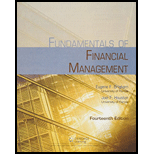
Concept explainers
a.
To calculate:
Present value of cash flow: It is also called as discounted value, it defines that amount of money that is invested at a given rate of interest, which will further increase the amount of future cash flow at that particular time in future.
a.
Explanation of Solution
Solution:
Calculation of present value of cash flow stream at 8% discounting rate
| Year | Discounting Rate | Cash Flows | Present value of cash flows | ||
| Stream A | Stream B |
Stream A |
Stream B |
||
| A | B | C | D | E | F |
| 0 | 1.000000 | 0 | 0 | 0 | 0 |
| 1 | 0.92592 | 100 | 300 | $92.592 | $277.77 |
| 2 | 0.85733 | 400 | 400 | $342.932 | $342.932 |
| 3 | 0.79383 | 400 | 400 | $317.532 | $317.532 |
| 4 | 0.73502 | 400 | 400 | $294.008 | $294.008 |
| 5 | 0.68058 | 300 | 100 | $204.174 | $68.058 |
| Present value for Stream A and Stream B | $1248.23 | $1300.306 | |||
Table (1)
Working Note to calculate discounting rate
Formula to calculate discounting rate for year 1
Formula to calculate discounting rate for year 2
Formula to calculate discounting rate for year 3
Formula to calculate discounting rate for year 4
Formula to calculate discounting rate for year 5
Present value for stream A and stream B is $1248.23 and $1300.306 respectively.
b.
To calculate: Present value of cash flow stream at 0% discounting rate.
b.
Explanation of Solution
Solution:
Calculation of present value of cash flow stream at 0% discounting rate
| Year | Discounting Rate | Cash Flows | Present value of cash flows | ||
| Stream A | Stream B |
Stream A |
Stream B |
||
| A | B | C | D | E | F |
| 0 | 1.000000 | 0 | 0 | 0 | 0 |
| 1 | 1.000000 | 100 | 300 | $100 | $300 |
| 2 | 1.000000 | 400 | 400 | $400 | $400 |
| 3 | 1.000000 | 400 | 400 | $400 |
$400 |
| 4 | 1.000000 | 400 | 400 | $400 | $400 |
| 5 | 1.000000 | 300 | 100 | $300 | $100 |
| Present value for Stream A and Stream B | $1600 | $1600 | |||
Table (2)
Working Note to calculate discounting rate
Formula to calculate discounting rate for year 1
Formula to calculate discounting rate for year 2
Formula to calculate discounting rate for year 3
Formula to calculate discounting rate for year 4
Formula to calculate discounting rate for year 5
Present value for stream A and stream B is $1600 and $1600 respectively.
Want to see more full solutions like this?
Chapter 5 Solutions
Bundle: Fundamentals of Financial Management, 14th + LMS Integrated for MindTap Finance, 1 term (6 months) Printed Access Card
- 6. Calculate the price of a dividend paying stock using the following information, assuming the price is equal to the present value of all future dividends one will receive from owning the stock. (Hint: treat the stock as a growing perpetuity) Dividend $4.50 Growth rate 2% Required return 12% *arrow_forwardFinance question. None please listen if you deslike my answer i will give your also they change rule for sublitt. Also if you will give more deslike bartleby site will be shut down.arrow_forwardProvide true solution.arrow_forward
- Finance question. None please listen if you deslike my answer i will give your. Also if you will give more deslike bartleby site will be shut down.arrow_forwardFinance question. None please listen if you deslike my answer i will give your. Also if you will give more deslike bartleby site will be shut down.arrow_forwardCorrect solnarrow_forward
- Principles of Accounting Volume 2AccountingISBN:9781947172609Author:OpenStaxPublisher:OpenStax College
 Managerial Accounting: The Cornerstone of Busines...AccountingISBN:9781337115773Author:Maryanne M. Mowen, Don R. Hansen, Dan L. HeitgerPublisher:Cengage Learning
Managerial Accounting: The Cornerstone of Busines...AccountingISBN:9781337115773Author:Maryanne M. Mowen, Don R. Hansen, Dan L. HeitgerPublisher:Cengage Learning



